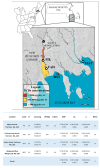Evolutionary Toxicogenomics of the Striped Killifish (Fundulus majalis) in the New Bedford Harbor (Massachusetts, USA)
- PMID: 30841640
- PMCID: PMC6429206
- DOI: 10.3390/ijms20051129
Evolutionary Toxicogenomics of the Striped Killifish (Fundulus majalis) in the New Bedford Harbor (Massachusetts, USA)
Abstract
In this paper, we used a Genotyping-by-Sequencing (GBS) approach to find and genotype more than 4000 genome-wide SNPs (Single Nucleotide Polymorphisms) from striped killifish exposed to a variety of polychlorinated biphenyls (PCBs) and other aromatic pollutants in New Bedford Harbor (NBH, Massachusetts, USA). The aims of this study were to identify the genetic consequences of exposure to aquatic pollutants and detect genes that may be under selection. Low genetic diversity (HE and π) was found in the site exposed to the highest pollution level, but the pattern of genetic diversity did not match the pollution levels. Extensive connectivity was detected among sampling sites, which suggests that balanced gene flow may explain the lack of genetic variation in response to pollution levels. Tests for selection identified 539 candidate outliers, but many of the candidate outliers were not shared among tests. Differences among test results likely reflect different test assumptions and the complex pollutant mixture. Potentially, selectively important loci are associated with 151 SNPs, and enrichment analysis suggests a likely involvement of these genes with pollutants that occur in NBH. This result suggests that selective processes at genes targeted by pollutants may be occurring, even at a small geographical scale, and may allow the local striped killifish to resist the high pollution levels.
Keywords: GBS; SNPs; candidate outliers; evolutionary genomics; migration; toxicant resistance.
Conflict of interest statement
The authors declare no conflict of interest.
Figures




Similar articles
-
Regulation of pregnane-X-receptor, CYP3A and P-glycoprotein genes in the PCB-resistant killifish (Fundulus heteroclitus) population from New Bedford Harbor.Aquat Toxicol. 2015 Feb;159:198-207. doi: 10.1016/j.aquatox.2014.12.010. Epub 2014 Dec 18. Aquat Toxicol. 2015. PMID: 25553538 Free PMC article.
-
Genetic variation at aryl hydrocarbon receptor (AHR) loci in populations of Atlantic killifish (Fundulus heteroclitus) inhabiting polluted and reference habitats.BMC Evol Biol. 2014 Jan 14;14:6. doi: 10.1186/1471-2148-14-6. BMC Evol Biol. 2014. PMID: 24422594 Free PMC article.
-
Expression and function of ryanodine receptor related pathways in PCB tolerant Atlantic killifish (Fundulus heteroclitus) from New Bedford Harbor, MA, USA.Aquat Toxicol. 2015 Feb;159:156-66. doi: 10.1016/j.aquatox.2014.12.017. Epub 2014 Dec 19. Aquat Toxicol. 2015. PMID: 25546006 Free PMC article.
-
Use of ecotoxicological tools to evaluate the health of New Bedford Harbor sediments: a microbial biomarker approach.Environ Health Perspect. 2005 Feb;113(2):186-91. doi: 10.1289/ehp.6934. Environ Health Perspect. 2005. PMID: 15687056 Free PMC article. Review.
-
When evolution is the solution to pollution: Key principles, and lessons from rapid repeated adaptation of killifish (Fundulus heteroclitus) populations.Evol Appl. 2017 Apr 26;10(8):762-783. doi: 10.1111/eva.12470. eCollection 2017 Sep. Evol Appl. 2017. PMID: 29151869 Free PMC article. Review.
Cited by
-
Seascape Genomics of the Sugar Kelp Saccharina latissima along the North Eastern Atlantic Latitudinal Gradient.Genes (Basel). 2020 Dec 13;11(12):1503. doi: 10.3390/genes11121503. Genes (Basel). 2020. PMID: 33322137 Free PMC article.
-
Immunotoxicity of Xenobiotics in Fish: A Role for the Aryl Hydrocarbon Receptor (AhR)?Int J Mol Sci. 2021 Aug 31;22(17):9460. doi: 10.3390/ijms22179460. Int J Mol Sci. 2021. PMID: 34502366 Free PMC article. Review.
References
-
- Cope W.G., Leidy R.B., Hodgson E. Classes of toxicants: use classes. In: Hodgson E., editor. A Textbook of Modern Toxicology. John Wiley and Sons Inc.; New York, NY, USA: 2004. pp. 49–74.
-
- Wisdom H.L. Contamination of the marine environment from land–based sources. Mar. Pollut. Bull. 1992;25:32–36.
-
- GESAMP Reducing environmental impacts of coastal aquaculture. Rep. Stud. 1991;47
-
- Johnston E.L., Mayer–Pinto M., Crowe T.P., Frid C. Chemical contaminant effects on marine ecosystem functioning. J. Appl. Ecol. 2015;52:140–149. doi: 10.1111/1365-2664.12355. - DOI
-
- Hamilton P.B., Cowx I.G., Oleksiak M.F., Grahn M., Stevens J.R., Carvalho G.R., Nicol E., Tyler C.R. Population-level consequences for wild fish exposed to sublethal concentrations of chemicals–a critical review. Fish Fish. 2015;17:545–566. doi: 10.1111/faf.12125. - DOI
MeSH terms
Substances
LinkOut - more resources
Full Text Sources
Research Materials
Miscellaneous

